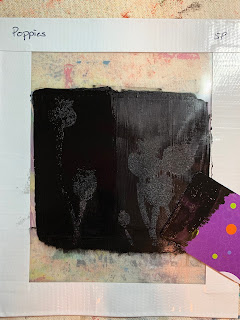If you've been a follower of our blog, you've probably noticed that we haven't posted in a few months. Sometimes life happens, and certain things become less important. Sue lost her mother in May, not an unexpected event as she was 97, but still, losing your mother is never easy. And keeping up with a blog has not been a priority. We have been posting regularly on Facebook and Instagram though so hopefully you've kept up with us there. Unfortunately, once you step away from a blog routine, it is easy to let it slide. We often wonder if people are really reading it; is it worth the time that goes into it? I guess we'll see.
The impetus for finally getting back to the blog is the current show called
Sacred Threads that is on exhibit here in Northern Virginia. It's got another week to go so if you are anywhere near by, it is well worth your time to make the trip to see it. This show is unlike any other, in that it features quilts on the topic areas of joy, inspiration, grief, healing, spirituality and peace/brotherhood. The maze-like set-up provides a very intimate setting as soft music plays in the background. It can be a very emotional experience, especially in the section devoted to grief and healing.
Sue took some time to visit the show last week and was back for a lecture and second look on Sunday. She has a quilt in the joy segment of the show. These are just a few of the quilts that made an impact on her in one way or another.
Dancing on Dappled Ground is by Norma Fredrickson of Berryville, VA. Norma is a customer of our Thermofax screen business, so it was nice to see some of her art work in person.
This is Sue's piece called The Bridesmaid. It is based on a photo of her daughter when she was a bridesmaid in her childhood friend's wedding. Both this and Norma's piece are in the "joy" section.
Ashes of Roses in the spirituality section is by Ellen Eriksen Parrott of Dansville, MI. The maker has a collection of vintage photos of infants in christening gowns and based this on one of those photos. She sees both the promise and hope for the child's future while also realizing that this child's life is probably over. Having spent time recently going though vintage family photos is probably what attracted Sue to this piece.
Another piece in the spirituality section is The Stone Bridge by Patricia Caldwell of Cottonwood, AZ. Patricia's work is frequently featured in Vicki Welsh's newsletter (Vicki is a fabric dyer), so it was intriguing to see some of Patricia's work in person.
Another spirituality piece is Mechanical Man by Jim Vander Noot of West Chester, PA. According to Jim, the mechanical man represents those things in our daily routine we do automatically, yet the spark of life pokes through the cracks. This is one of those pieces that the closer you look, the more you are drawn in and begin asking 'how did he do that?"
Suspended Moments is by Gabriele DiTota of Melbourne, FL and was part of the healing section. This piece reflects time spent in a garden and moments in nature that restore the spirit. The first thing Sue was attracted to was the cyanotype prints in the center, and then the surrounding fabrics with their varied surface design also became apparent.
In the inspiration section was Boundless Love - Cuddle Time by Jane L. King of Longmont CO showing the connection between mother and child. The soft colors and quilt in the background add to the feeling of calm and peacefulness.
The quilts in the grief section illicit the most emotional reactions. This piece called Pulse is by Martha Wolfe of Davis, CA. It shares the text messages from a young man to his mother inside the Pulse nightclub. As a quilter, Ms. Wolfe is tired of making hearts for victims of mass shootings, and we agree.
Death Toll by Susan Brubaker Knapp of Mooresville, NC is another quilt in the grief section. It was made to express her sorrow and outrage after the shooting at Marjory Stoneman Douglas High School. The 17 roses represent the 17 victims. The tic marks represent those killed in mass shootings since 1984 by AR-15.
And back to the section on joy, was this quilt called Daisy Field Exploration by Roberta G. Porter of Batavia, OH. It is based on a photo of the maker's granddaughter when she was 4 years old and the connection to the natural world that brings joy and beauty.
This is just a small sampling of the 245 quilts in the Sacred Threads exhibit. In addition, there is a special exhibit called Eye Contact. Quilters were invited to submit 5" x 23" pieces featuring only eyes. All submission were accepted for display, and made for a fabulous addition to the show.





















































